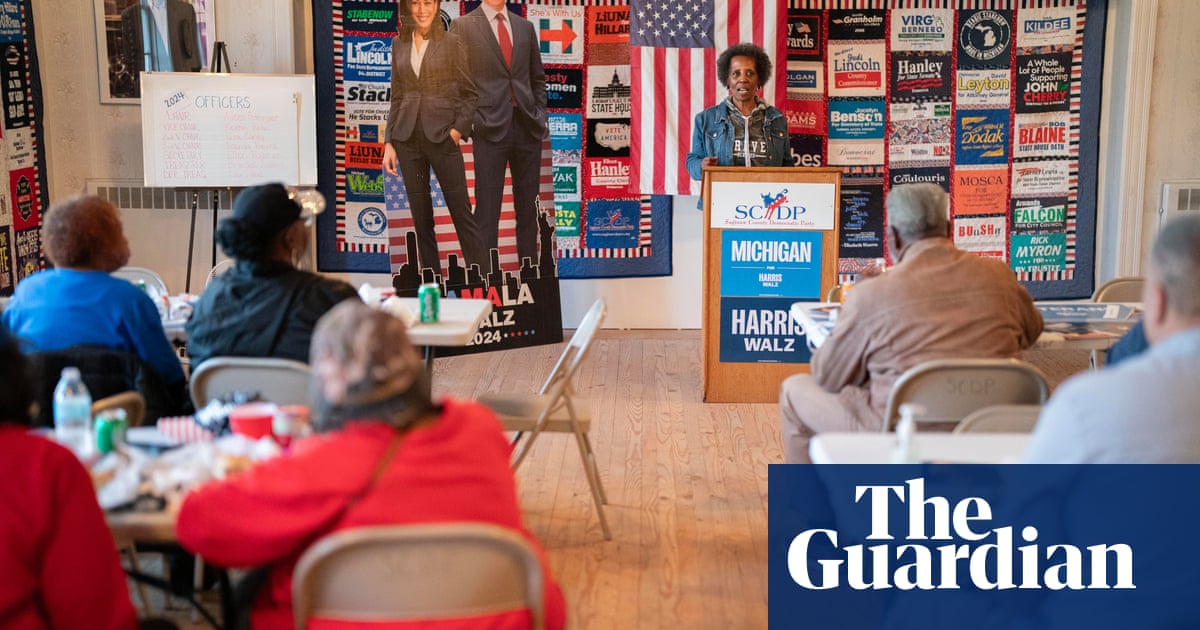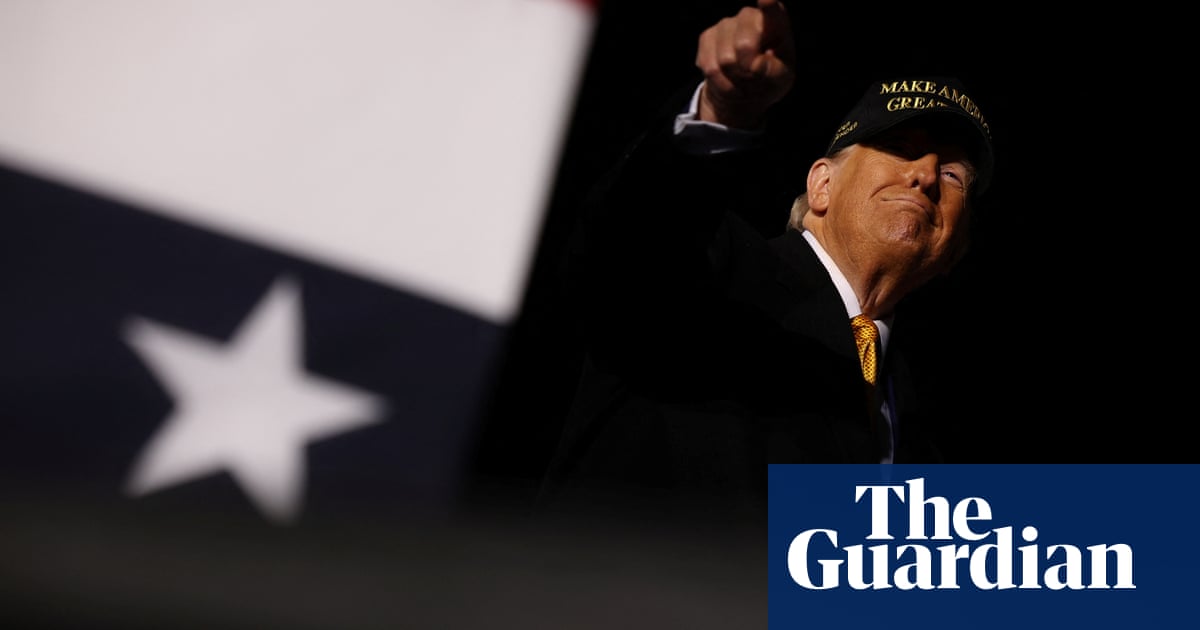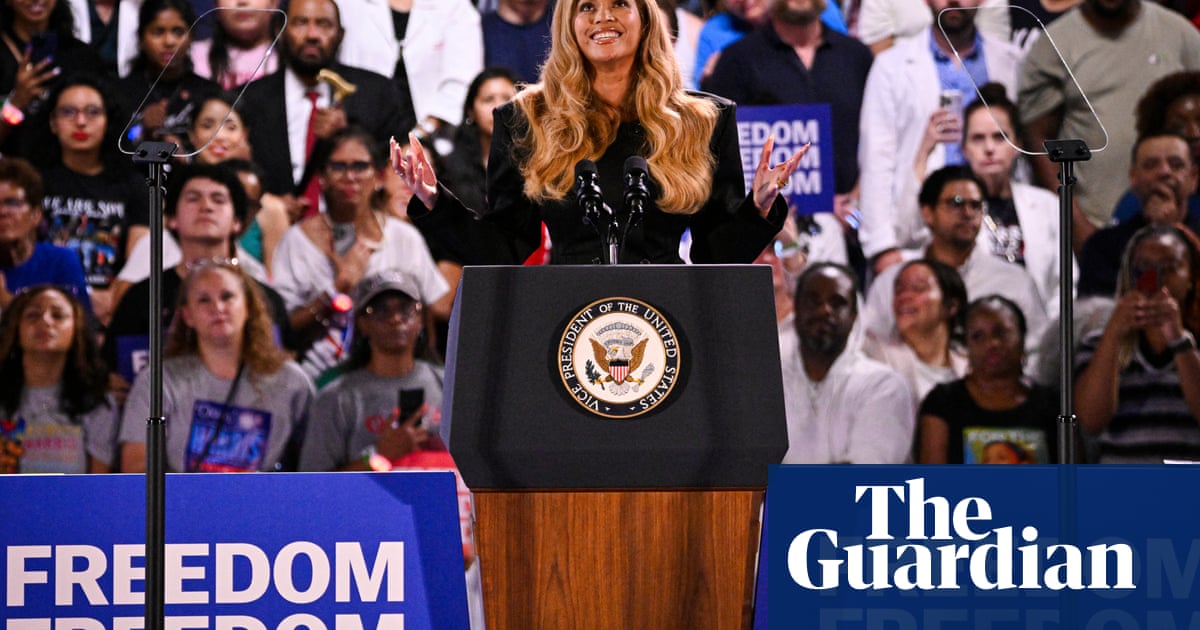Members of building trades unions listen to labor leaders speak at the painters' union hall in Big Bend, Wisconsin, on Oct. 19, before heading out to knock doors for Kamala Harris. Daniel Marans/HuffPost
SOUTHEAST WISCONSIN — Flanked by several leaders of the 13 building trades unions whose members are constructing a massive artificial intelligence data center in a rural area south of Milwaukee, Mitch Landrieu, the co-chair of Vice President Kamala Harris’ presidential campaign and former White House infrastructure czar, had what looked like an easy task before him.
The hundreds of hard hat-clad union members gathered in the dining hall, now eating bagged lunches courtesy of the Harris campaign, held some of the thousands of jobs that sprang indirectly from President Joe Biden’s investments in infrastructure and his commitment to using union labor. Landrieu was there to remind them of that.
The soon-to-be-running data center — whose construction was commissioned by a multinational corporation that did not grant permission for a reporter to be present at the luncheon — sits next to a complex of facilities run by Chinese electronics giant Foxconn, a company whose history in Wisconsin attests to former President Donald Trump’s shortcomings as a champion of manufacturing. Despite major state and local government incentives, the company reduced its planned investment in the site from $10 billion to $672 million, and much of the facilities it has completed remain empty.
Landrieu stopped short of an explicit call to vote for Harris. But he emphasized the White House’s commitment to union labor, recalling how whenever “the word ‘jobs’ was mentioned” in meetings with Harris and Biden, they would insist on not just jobs but “high-paying union jobs.”
After that line, and again at the close of his remarks, Landrieu got at least some applause from the assembled union members.
Mitch Landrieu, who shepherded the implementation of the bipartisan infrastructure bill, emphasized that and other bill's impact to Wisconsin union members. Kevin Dietsch/Getty Images
But amid the din of chatter following Landrieu’s remarks, one union member got up from his table and chanted in a singsong tone, “Fuck Joe Biden!”
No one joined in. Before walking off, the worker muttered, “I don’t believe any of this bullshit.”
That outburst, however modest, illustrates the frustrating quandary facing many Democrats this election cycle: Despite all that Harris and Biden have done for unions ― tapping pro-union government officials, boosting legislation that grew union jobs ― a national Pew Research poll shows Harris on track to best former President Donald Trump among union members by just seven percentage points. That’s a worryingly low margin for the Democratic nominee among a traditionally Democratic constituency.
Worse still, two of the country’s largest unions, the International Brotherhood of Teamsters and the International Association of Fire Fighters, have declined to endorse in the presidential election, citing their members’ divided views.
Even as Harris hopes to improve on Biden’s margins with moderate Republicans and independents in the college-educated suburbs of Milwaukee, Detroit, and Philadelphia, she has little room to spare when it comes to their non-college-educated counterparts.
Voters without a college degree, whose exodus toward the Republican Party accelerated under Trump, are still more likely to vote for Democrats if they belong to a union. Biden, a native of blue-collar Scranton, Pennsylvania, won in 2020 thanks in part to an improvement in his performance with union members relative to 2016 candidate Hillary Clinton.
If Harris fails to match Biden’s marks with unions, it could easily cost her the presidency.
A defeat for Harris could in turn both jeopardize the gains that the labor movement has accrued in the past four years and plunge the Democratic Party into an identity crisis about its ability to win over working-class voters altogether. Biden’s pivot toward aggressively supporting organized labor, which marked a break with a business-friendly shift in the party that had held sway since Bill Clinton’s nomination, was born out of sincere policy convictions, but also of a theory that Democrats could undermine Trump’s appeal by championing workers’ rights.
Jimmy Williams, general president of the International Union of Painters and Allied Trades, address union members at a canvassing kickoff in Big Bend, Wisconsin. Daniel Marans
Paying It Forward
The heavily male, blue-collar labor unions working overtime to convince their more conservative members to vote for Harris understand that the gains they have made in the past four years, in terms of both dollars and political power, hang in the balance.
“The last four years, this union and all of our unions combined have had more influence over the federal government than at any other time in my lifetime,” Jimmy Williams, general president of the 120,000-member International Union of Painters and Allied Trades, said in an Oct. 19 speech in Big Bend, Wisconsin.
“We cannot go backwards!” he told the crowd of more than a hundred politically active union members from Wisconsin and neighboring Illinois who were set to knock on fellow members’ doors that day for the Harris campaign.
Williams shared how he makes his pitch for Harris: “You’re either going to be at the table or you’re going to be on the outside looking in. And for the last four years, we’ve been able to create policies that help our members.”
At the entrance of the IUPAT District Council 7 union hall, a neighbor's Trump sign is visible behind the union's signs for Harris and Sen. Tammy Baldwin (D-Wis.). Daniel Marans/HuffPost
The IUPAT's District Council 7 union hall doubles as a training center for union apprentices learning how to paint, finish drywall, install glass and display signs, among other skills. Daniel Marans/HuffPost
Williams, who also introduced Landrieu at the data center construction site on Monday, was visiting the IUPAT’s District Council 7 as part of a month-long tour of swing states. He’s been road-tripping in a van wrapped in the IUPAT’s black-and-yellow colors and decorated with its slogan: “One union, one family, one fight!”
District Council 7 has 2,000 members across Wisconsin and Michigan’s Upper Peninsula, including commercial and industrial painters, drywall finishers, glaziers, sign and display installers, and paint makers. The large Harris and Sen. Tammy Baldwin (D-Wis.) campaign signs at the entrance of the council office, which doubles as a massive training facility for trades apprentices, make the facility stick out alongside its neighbors. Visitors arriving at the union hall after descending I-43 from Milwaukee must pass a row of properties festooned with pro-Trump signs and flags before reaching this Democratic outpost.
Leaving from the union hall, Williams, a fourth-generation IUPAT member from outside Philadelphia, got in a van to knock on members’ doors in southwestern Waukesha County and northeastern Jefferson County. He recounted why he thinks many unions are so committed to Harris’ campaign, even as they struggle to get some of their rank-and-file members on board.
IUPAT General President Jimmy Williams has been touring swing states in a van to rally union members behind Harris and other Democratic candidates. Daniel Marans/HuffPost
Williams, right, and Jennipher Neduzak, communications director for IUPAT District Council 7, approach the home of union members with a Donald Trump sign on their lawn. Daniel Marans/HuffPost
When Biden got into office, it finally felt like Democrats were returning to their pre-1980s roots as a firmly pro-labor party, according to Williams. Biden has shown solidarity with organized labor through his bully pulpit — he became the first president to walk a picket line when he joined striking United Auto Workers members in Michigan in Sept. 2023 — and through his picks for federal agencies.
He appointed Marty Walsh, a former building trades union leader, as his first secretary of labor. Jennifer Abruzzo, Biden’s appointee as general counsel to the National Labor Relations Board, has used new tools to punish union-busting employers and protect workers trying to organize. Under Abruzzo and the NLRB’s other pro-union officials, the success rate of union recognition elections has gone up significantly, prompting a historic surge in petitions for such elections.
Biden’s legislative priorities have been even more important to cementing his legacy as a champion of organized labor. He oversaw the inclusion of upwards of $65 billion into the American Rescue Plan Act to bail out the troubled pension funds of more than 1 million union members. Then he passed a series of union-friendly public investment bills — the bipartisan infrastructure law, the CHIPS and Science Act, and the Inflation Reduction Act — that spurred a union jobs bonanza, especially for the building trades.
The IUPAT alone has seen its membership grow by 3,500 people, bringing it to the highest level since before the 2008 financial crisis, when the union had 140,000 active members, according to Williams.
Backing Harris, who kicked off a national abortion rights tour at the DC 7 facility in January, was not a hard choice, Williams said.
“How could you not support the person who was with him the most on all these issues that have been great for our members and great for our union?”
Explaining The Disconnect
To Williams, Harris and Biden’s embrace of union priorities is all the more important because it follows the more business-friendly Obama and Clinton administrations, when organized labor often had to settle for table scraps. He winced at the memory of Barack Obama shelving the Employee Free Choice Act, a bill to make union organizing easier, early on in his presidency.
One reason union members might still be skeptical of Democrats, despite what Biden and Harris have done, is because of those decades of accumulated distrust, Williams argued.
“It was like the choice of the lesser of two evils when it came to union membership, the working-class issues that the union movement values,” Williams said of the pre-Biden era.
Democrats “never did anything, and that’s part of the reason why we’re playing an uphill battle right now politically with our members. They know that. They felt it,” he added. “I personally believe that part of Trump’s ability to cut into the working class is because the Democratic Party really never delivered for working people for two generations.”
Other labor movement veterans had different theories about working-class people’s motivations for voting Republican.
Williams, left, and Jeff Mehrhoff, business manager for IUPAT District Council 7, walk back to the van after knocking on a member's door. Daniel Marans/HuffPost
“A lot of it is misogynistic — she’s a woman,” said Jeff Mehrhoff, the business manager for IUPAT DC 7, who went door-knocking with Williams. “And let’s be real: Wisconsin is a pretty white state — a lot of old white people here — and it’s race. I hate to say it, but I think it’s pretty true.”
Mike Mikus, a Pittsburgh-based Democratic strategist who works closely with unions, wishes the Biden administration had done a better job promoting its achievements for workers earlier and more consistently. “It’s almost like Democrats don’t want to brag about anything,” he said.
And Williams maintains that the Harris campaign’s message about middle-class tax cuts and various targeted loans for small businesses and first-time home buyers don’t resonate as much with his members, who are concerned about decent jobs first and foremost.
“You’ve got to get to the core group of what the American working class really needs, which is security — retirement security, health care security,” he said. “All the things that we represent have to be at the center of what her economic message is from today.”
He also acknowledged his concern that Harris’ courtship of the business community, as embodied by the hearty endorsement of billionaire Mark Cuban, among others, might signal a reversion to the Democratic Party mean. “It’s a nod back to what the Democratic Party was before Biden,” he said.
Diminished Influence
In addition to highlighting Biden and Harris’ achievements for union members, organized labor is warning its members about Project 2025, a governing blueprint for Trump’s second term drafted by the right-wing Heritage Foundation.
The think tank’s labor policy recommendations include doing away with a law requiring construction companies contracting with the federal government to pay the “prevailing wage,” and adopting a law allowing employers to grant limited time off in lieu of time-and-a-half overtime pay.
“Trump says, ‘No tax on overtime.’ You know, he’ll keep that promise. A lot of our members think that’s a good thing,” Dan Bukiewicz, president of the Miwaukee Building & Construction Trades Council, said at Saturday’s canvassing kickoff.
“Can I tell you what? You ain’t going to have any overtime. You’re going to be all working for straight time, regardless of the day or how many hours you are there. Just plain and simple, it’s easy not to tax it when it doesn’t exist and will go away.”
Trump has sought to distance himself from Project 2025, but his ties to its architects run deep.
And during Trump’s last term, he demonstrated little willingness to break with free-market conservative dogma outside of trade and immigration policy. Trump’s Department of Labor, in particular, was as anti-union as they come. Among other steps, his administration undid Obama’s expansion of overtime eligibility and tried, unsuccessfully, to strip building trades unions of their monopoly on federally-recognized apprenticeship programs.
IUPAT and other building trades members from Wisconsin and Illinois pose for a group photo with Williams, Mehrhoff, and Stephanie Bloomingdale, president of the Wisconsin AFL-CIO. Daniel Marans/HuffPost
But the union officials who riled up the crowd of canvassers on Saturday were speaking to members who are already committed political volunteers.
The broader membership of the individual building trades unions is naturally much more varied in its views — and less acquainted with union leaders’ ways of looking at politics.
Sure enough, the IUPAT members at the data center construction site who expressed ambivalence about Harris cited something unrelated to unions: the inflation that had eroded their earnings in recent years. Food prices in particular went up nearly 26% from Nov. 2020 to March 2024.
While inflation has been a global problem since the end of the COVID-19 pandemic and most experts believe Biden’s policies have had only a marginal impact, voters often blame the party in power for economic troubles that occur on their watch, regardless of their underlying causes.
Hunter Proft, an undecided first-year IUPAT apprentice who has never voted before, does not think Trump is being entirely honest when he lays the blame for inflation at Biden’s feet. But his own experience with inflation still made him receptive to the Republican nominee’s pitch.
“The four years [Trump] was in office, I didn’t really see much change in my lifestyle,” Proft said. “Since [Biden] was president, I’ve felt a decline in me being able to support my family and stuff.”
Alesha Smith, another first-year IUPAT apprentice from Racine who voted for Biden in 2020, likes Harris and her proposals, but isn’t sure if she can trust her to follow through.
“Inflation and everything go up — it’s harder to just find simple things than it should be,” Smith said. “She had the power to change some stuff while she was there. She hasn’t.”
Alesha Smith, a first-year IUPAT apprentice from Racine, Wisconsin, voted for Joe Biden in 2020, but is still undecided this year. The photo is blurry because HuffPost did not have permission to portray the construction site. Daniel Marans/HuffPost
Outside the PPG Industries paint coating factory in Oak Creek, Wisconsin, IUPAT members who said they were backing Harris often first invoked Trump’s character and authoritarian tendencies, rather than his labor policies, to explain their aversion to him.
“One’s a liar and he’s going to do what he wants to do. The other one, she hasn’t done much,” said Rudy Villalobos, a Franklin resident and veteran of the U.S. Marines. “I’ll still vote for her, because Trump said he wants to be a dictator.”
Asked whether the union’s endorsement of Harris made a difference, Villalobos said, “The Trump people, they’re not union. They don’t care about the middle class or the lower class at all.”
Villalobos’ ex-wife and daughter are supporting Trump, however, because of their belief he’d be better for small businesses.
One Trump voter leaving the PPG plant, who refused to provide his name because “liberals are crazy,” said that while he is a committed union member, even paying dues in a state where he’s allowed to opt out of them, he has always ignored union leaders’ political advice.
“I don’t pay it no mind,” said the Glendale resident. “They always support the Democrats. I don’t know why.”
He said he’s backing Trump because he believes excessive immigration is “lowering our wages.”
The same labor unions that were once so influential they could deliver entire states to Democrats — from West Virginia to Michigan — on the strength of their membership alone now have neither those decisive numbers nor as much sway over their remaining members.
Prior to the country’s anti-labor turn in the late 1970s, unions played a more central role in not just the economy and politics but in working-class social and cultural life, anchoring the drinking clubs and charitable organizations in industrial towns. Members at that time might also have personal memories of a more precarious life before the New Deal, when the federal government extended its protective might to the labor movement, prompting the country’s first — and only — Golden Age for organized labor.
But in an era where unions must compete for attention with the likes of megachurches and social media influencers, union members are more apt to see their relationship to the union through a transactional lens — union dues for higher pay and benefits, politics be damned.
What’s more, while unions’ influence has slowed the drift of their non-college-educated, white male members to the right, no American is immune to the effects of political and demographic polarization. And aside from law enforcement unions, members of the building trades unions — which are overwhelmingly male and largely white — are typically among the labor movement’s most conservative members. A number of lunch boxes at the data center job site were plastered with National Rifle Association stickers, for example.
“They’re all the demographic that votes for Trump,” Mikus said.
These building trades union members’ conservatism, in turn, sometimes feeds a cycle where union leaders take a less aggressive approach to political education for fear of alienating the members who elect them to their posts.
“If you’re in a local with two-thirds of your members that don’t agree with your endorsement, it’s going to be difficult for you to stand out there on a ledge,” Williams said. “This is how I say it to members: ‘You pay me to tell you the truth in regards to labor policies, that’s my job. You don’t have to listen to me. You don’t have to agree with me.’”
Williams, the IUPAT general president, takes a smoke break between canvassing stops. He goes through about one pack of American Spirit cigarettes a day. Daniel Marans/HuffPost
A Path Forward
IUPAT is widely considered the most progressive of the building trades unions. The group connects its members’ interests to other social causes, including by marching with the Black Lives Matter movement in 2020 and commemorating the Juneteenth holiday. It was the first building trades union to elect a Black leader, former general president Kenneth Rigmaiden. The union has set a long-term goal to have 20% of its members be women, and has begun recruiting heavily among Black and Latino workers, who had not always been welcome.
Regardless of the election’s outcome though, Williams is committed to communicating with members more regularly about how the IUPAT fits into the broader sweep of labor history and the ways in which political choices, however remote they may feel, affect members’ lives.
“Every time you just keep coming to them around elections, you get further and further from what’s really driving them on a day-to-day basis,” Williams said. “This has to be done, but it can be done so much easier when you’re talking to your members every day or every week. And then you add into it, after you’ve already built that trust back, and after you’ve built that type of relationship with them: ‘Hey, we also need you to vote.’ It’s such an easier conversation. It just is.”

 German (DE)
German (DE)  English (US)
English (US)  Spanish (ES)
Spanish (ES)  French (FR)
French (FR)  Hindi (IN)
Hindi (IN)  Italian (IT)
Italian (IT)  Russian (RU)
Russian (RU) 
































Comments